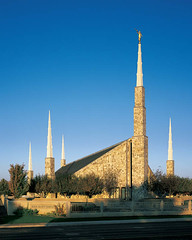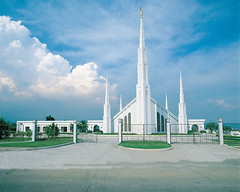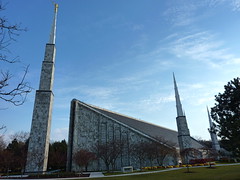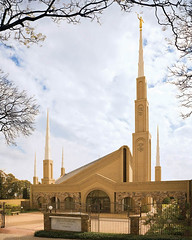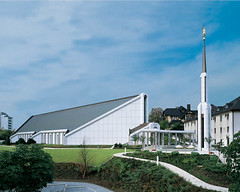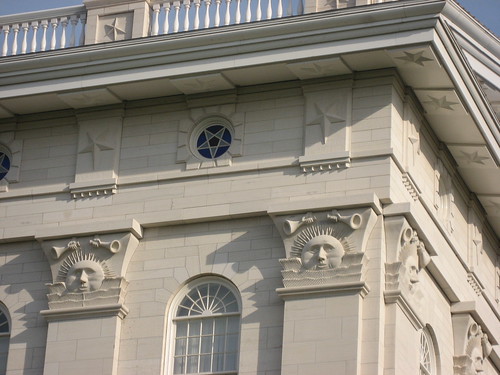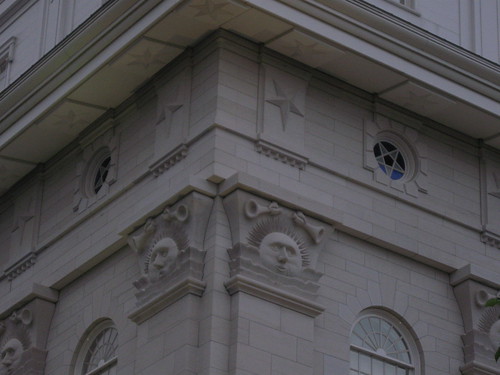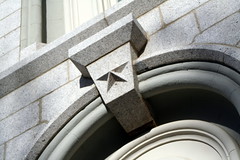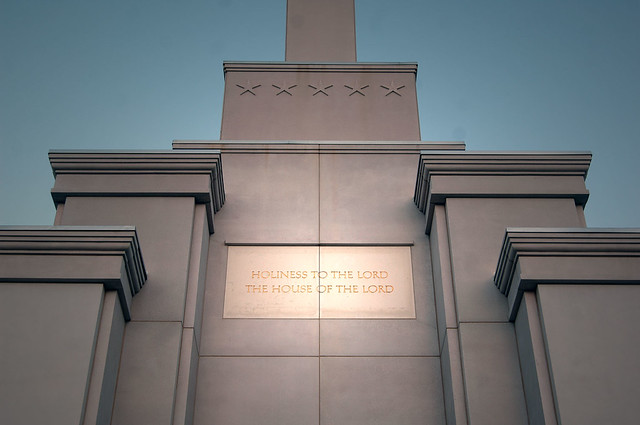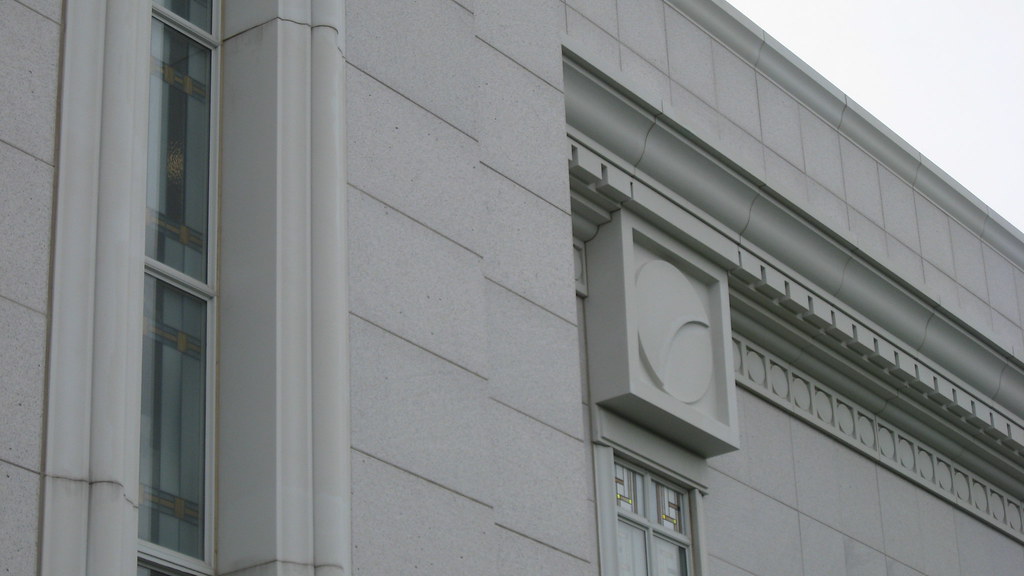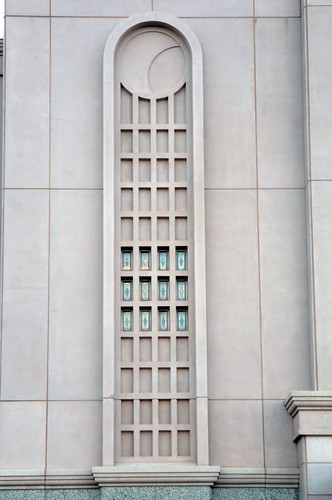The Sun has been used as a temple symbol from the second Latter-day Saint temple, the Nauvoo Temple. This symbol has a lot of meaning, and that meaning varies depending on how it is used on a particular temple. Sometimes the symbol may have multiple meanings on a given temple adding a rich depth of symbolism. I'm going to focus on sun
stones mainly and skip over sun symbols in glass.

The first sunstone was on the Nauvoo Illinois Temple. Three of the original thirty sunstones have survived and can be seen in the Nauvoo
Church of Jesus Christ of Latter-day Saints visitor's center, Nauvoo Community of Christ visitor's center, and in the
Smithsonian Museum of American History in Washington D.C. right next to the original star spangled banner. The rebuilt temple has sunstones matching the originals.
These sunstones in the Nauvoo Temple had a face on them. This was apparently supposed to represent an actual person. Joseph Smith was asked by a builder "Is this like the face you saw in vision?" and Joseph replied "Very near it" (
See FAIR article). So apparently the face had some added significance.
The suns on the sunstones were rising above either waves or clouds (there are conflicting accounts from the builders). Early plans also had the sun rising above acanthus leaves, something that was worked into the rebuilt temple's interior (see photo on the right). The sunstones formed the capitols of exterior pilasters together with the clouds/sea and the trumpet stones just above the sunstones. The trumpet stones are what I named this blog after. Some sources call them cornucopias, but the Salt Lake Temple plans show them clearly as trumpets (later the Salt Lake Temple trumpets were removed). On the Nauvoo Temple, the sunstone's strongest intended meaning was not the celestial kingdom. Wandel Mace, one of the temple foremen, said:
The order of architecture [on the Nauvoo Temple] was unlike anything in existence; it was purely original; being a representation of the Church, the Bride, the Lamb's wife. John the Revelator, in the 12[th] chapter [and] first verse of [the book of Revelation] says, 'And there appeared a great wonder in heaven; a woman clothed with the sun, and the moon under her feet, and upon her head a crown of twelve stars.' This is portrayed in the beautifully cut stone of this grand temple. (See FAIR article)
The next temple with sunstones was the Salt Lake Temple. The symbolic stones on the Salt Lake Temple follow the general arrangement of those on the Nauvoo Temple and therefore have similar meaning. So the sunstones primarily refer to the vision of John in the
Revelation. They do have some additional meaning as well. Time seems to be used as a symbol on the temple with earthstones (originally to be detailed going through hours of a day), moonstones in different phases representing days, weeks, and months. The sunstones could then represent the seasons and years as the sun moves north and south in the seasons. Each sunstone has 40 points and 40 is often used to represent a long period of time. The big dipper then would imply Polaris which never changes. So in this case the sunstones would also represent progression towards eternity.

Early plans for the Salt Lake Temple show faces on the sunstones, similar to those used on the Nauvoo Temple sunstones. This was probably changed when the temple material was switched to granite, making carving faces difficult. I like how the Salt Lake Temple sunstones include the whole sun instead of only showing the Nauvoo Temple rising sun (for variety, I like the Nauvoo version a lot). Originally the Salt Lake Temple's sunstones were intended to be gilded. It would have been cool to see them covered in gold. (See
New Era article)
The Washington D.C. Temple was the next to include the sun, although in this case it was a sun metal door detail. This sun is clearly inspired by the sunstones on both the Nauvoo Temple and Salt Lake Temple. The Salt Lake Temple's round shape is combined with the face from the Nauvoo Temple. The sun also appears to be rising. For more information on the Washington D.C. Temple doors you can read my post and accompanying links
here. The arrangement of symbols on these doors, although clearly borrowing from the earlier temples, implies that in this temple the sun (highest on the doors) is being used to represent the celestial kingdom with glory compared to that of the sun as in
1 Corinthians 15:40-42. This is how I think most members interpret the sunstone's symbolism, and for a lot of the later temples this is the primary intended meaning. Another way to interpret the symbolism on this temple (and others) is that the sun is a part of the heavens (along with the moon and stars) and so sunstones represent heavenly things and the temple is a heavenly place.
I think that the next temple with sunstones was the Portland Oregon Temple. These can be seen glowing brilliantly (they are thinly cut translucent stone) in the picture (you can see the full image in this
link). In this temple the sunstones are along the top of the temple and therefore line the top of the celestial room. This shows that they represent the celestial kingdom. At the same time, on the exterior of the temple, the symbols match those of the Salt Lake Temple and stars cover the spires above the sunstones meaning that the stones also are representing John's vision as in the Nauvoo and Salt Lake Temples. The style is clearly copying the Salt Lake Temple sunstone design. The way these stone windows glow also points out that sunstones can simply be used to represent light.
The Las Vegas Nevada Temple uses the same general floorplan as the Portland Temple. In Las Vegas, the sunstones are moved down slightly so the starstones can be on the main body of the temple instead of the spires. The
sunstones are made out of precast concrete in this case. The use of the sunstone in this temple implies John's vision. Inside the celestial room there is also a brilliantly cut crystal sun mandala used to represent Jesus Christ (see my
Las Vegas Temple post for more information on the symbolism). The sun mandala can be seen on the
manufacturer's website. Additionally, above many doors in this temple there are rising suns similar to the Nauvoo Temple suns, but semicircles and without faces.
The Bountiful Utah Temple and Mount Timpanogos Utah Temple both contain sunstones. There are 12 on each temple and they are at the base of each temple's spire. The photo to the right shows the stones on the Mt. Timpanogos Temple and the original photo can be found
here. A picture of the Bountiful Temple with visible sunstones can be found
here. On these temples the sunstones follow the Salt Lake and Nauvoo Temple pattern and most clearly refer to John's vision. Each temple also has suns on the doors seen on the Bountiful Temple
here, and on the Mount Timpanogos Temple
here, and
here and
here. These door suns are more stylized and look similar to flowers. I like that the spire suns have the rays going all the way to the center of the suns, making them different from previous temples' sun stones. The Bountiful Temple also includes Native American sun designs throughout the temple. Some can be seen in the main lobby on the top of wood columns. The largest is in the
celestial room stained glass window and therefore probably also represents the celestial kingdom.
The Bogota Columbia Temple also includes sunstones that can be seen
here. They are at the base of the spire and as far as I can tell there are 16 of them. This temple is similar to the Bountiful and Mount Timpanogos Temples.
The Preston England Temple has 2
sunstones. They are arranged alongside
starstones and moonstones. The 2 starstones are closest to the front doors and the center of each is a new moon. Then there are 4 moonstones increasing towards a full moon. Then there are the sunstones which are closest to the celestial room and sealing rooms. The center of each sunstone is actually a full moon. Clearly these stones are meant to represent progression. The sunstones represent the celestial kindgom. I like how the orientation and style of the sunstones are different than previous temples.

The Albuquerque New Mexico Temple again follows the Salt Lake Temple's symbolism. This time a single
sunstone is placed among moonstones implying progression and the celestial kingdom.
Starstones higher on the temple link the sunstone symbol to John's vision. Suns also appear in the
stained glass windows. Here is a
link to the original of the picture at the left.
 |
| Palmyra New York Temple Sunstone |
The Palmyra New York Temple is one of the first small temples. Unlike other temples of this style which simply use circles as a decorative pattern (with
circle in square symbolism), this temple has
moonstones and
sunstones and starstones. In Chad Hawkins' book
The First 100 Temples it states:
The sun and star stones of the temple are on the spire. There are four sunstones, each one facing a cardinal direction of the compass. Each sunstone has thirty-three rays of light, representing the number of years of the Savior's mortal experience. Higher on the spire are three stars adorning each of its four sides, totaling twelve stars. This design refers to the symbolic meanings represented by the numbers three and twelve.
If you read my post on the Las Vegas Nevada Temple, you'll remember that when a sun is paired with 12 stars it references Lehi's vision in 1 Nephi 1 and thereby makes the sun represent Jesus Christ. In the Palmyra Temple this is doubly emphasized by the 33 rays.
The Columbia River Washington Temple includes the symbols from the Salt Lake Temple but has moved the
sunstones to the
top of the spire. They look similar to those on the Bountiful and Mt. Timpanogos Temples.
The Newport Beach California Temple also used sunstones. In this case there are
a lot of them along the top of the temple. I'm not sure what other symbols are present except that if you look carefully you can see
stars cut into the top of the spire which may imply a John's vision interpretation of the symbols.

When the Soa Paulo Brazil Temple was recently remodeled they added suns to the tops of the Celestial Room columns. These are based on the rebuilt Nauvoo Temple's sun-rising-out-of-acanthus-leaves capitals, without faces, but with gilding. I like seeing this detail in a remodel and hope to see similar details in new temples.
Those are the sunstones I've been able to identify. 10-15 more temples include the sun symbolically in their stained glass, but that will have to wait for another post. To review, the sun as a temple symbol represents:
John's Vision in
Revelation 12:1
The Celestial Kingdom as described in
1 Corinthians 15:40-42
Eternal Progression
Time approaching eternity
Jesus Christ (especially when paired with 12 stars symbolizing his apostles).
Light
The Heavens
Please comment and let us know what you think, or if you know of any sunstones I may have missed.





